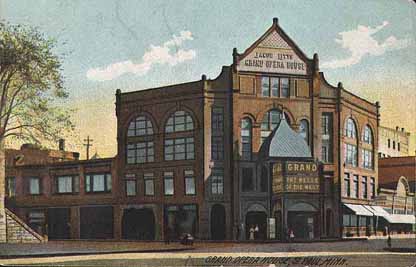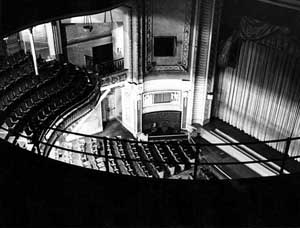Difference between revisions of "The Garrick Theater"
(table) |
m (Protected "The Garrick Theater" [edit=sysop:move=sysop]) |
||
| (3 intermediate revisions by one other user not shown) | |||
| Line 1: | Line 1: | ||
<div style="text-align: center;"> | <div style="text-align: center;"> | ||
| − | '''34 West Sixth Street, St. Paul, MN. ( | + | '''34 West Sixth Street, St. Paul, MN. (1890-1945?-1950)''' |
</div> | </div> | ||
| Line 9: | Line 9: | ||
! | ! | ||
|- | |- | ||
| − | | It began as many downtown St. Paul theaters did, with a spectacular first performance attended by the “leading families” of the city. At the southeast corner of St. Peter and Sixth street, the theater originally began as the Grand Opera House in 1890, when opera was a mainstay of American entertainment. | + | | It began as many downtown St. Paul theaters did, with a spectacular first performance attended by the “leading families” of the city. At the southeast corner of St. Peter and Sixth street, the theater originally began as the Grand Opera House in 1890, when opera was a mainstay of American entertainment.<small>(1)</small> |
| − | It became “The Garrick” in the 1910s, and subsequently showed first-run movies in the 20s and 30s. As time progressed, new art-deco movie palaces replaced the Garrick in eminence, and the theater eventually showed second and third-run films for a cheap price. | + | It became “The Garrick” in the 1910s, and subsequently showed first-run movies in the 20s and 30s.<small>(2)</small> As time progressed, new art-deco movie palaces replaced the Garrick in eminence, and the theater eventually showed second and third-run films for a cheap price. |
| [[Image:Svc_garrickpost.jpg]] <div style="text-align: center;"> | | [[Image:Svc_garrickpost.jpg]] <div style="text-align: center;"> | ||
<small>'''The "Grand Old Opera House" in 1905. Courtesy of the Minnesota Historical Society.'''</small> | <small>'''The "Grand Old Opera House" in 1905. Courtesy of the Minnesota Historical Society.'''</small> | ||
| Line 19: | Line 19: | ||
| − | Queer activity noticeably took place in this third and final era during the 1940s and 1950s. In a WWII-influenced world, run-down theaters were sites of sexual adventure. The faded Garrick, with “its upper facade still showing what was left of the once grand opera house,” was no exception. For, and in the men’s “lounge” of the double-feature showplace, men in the know approached one another for sexual activity. | + | Queer activity noticeably took place in this third and final era during the 1940s and 1950s. In a WWII-influenced world, run-down theaters were sites of sexual adventure. The faded Garrick, with “its upper facade still showing what was left of the once grand opera house,”<small>(3)</small> was no exception. For, and in the men’s “lounge” of the double-feature showplace, men in the know approached one another for sexual activity.<small>(4)</small> |
| Line 34: | Line 34: | ||
| − | These men—many of whom were married—risked arrest, violence, robbery, and losing their livelihoods as a result of approaching the wrong person. Such a threat makes postwar theater sex very different from similar activity that took place in gay erotic theaters 20 years later. | + | These men—many of whom were married—risked arrest, violence, robbery, and losing their livelihoods as a result of approaching the wrong person. Such a threat makes postwar theater sex very different from similar activity that took place in gay erotic theaters 20 years later (see: the [[Adonis/Flick Theaters]]. |
|} | |} | ||
| − | The activity persisted despite the risks until property owners replaced the building with a parking lot in the early 1950s. The City of St. Paul folded the Garrick’s site into the rest of its block in the late 1990s to prepare for the Lawson Law Office mega-block. The site is presently home to Kincaid’s Fish, Chop, and Steak House. | + | The activity persisted despite the risks until property owners replaced the building with a parking lot in the early 1950s.(5) The City of St. Paul folded the Garrick’s site into the rest of its block in the late 1990s to prepare for the Lawson Law Office mega-block. The site is presently home to Kincaid’s Fish, Chop, and Steak House. |
| Line 44: | Line 44: | ||
| − | + | <small>(1)</small>Krefft, Bryan. "The Garrick Theatre." http://cinematreasures.org/theater/4051/. | |
| + | |||
| + | <small>(2)</small>Kenney, Dave. ''Twin Cities Picture Show: A Century of Moviegoing.'' St. Paul: Minnesota Historical Society Press, 2007. Page 8. | ||
| + | |||
| + | <small>(3)</small> Brown, Ricardo J. ''The Evening Crowd at Kirmser's: A Gay Life in the 1940s.'' Minneapolis: University of Minnesota Press, 2001. Page 8. | ||
| + | |||
| + | (4) ''Ibid.'' | ||
| + | |||
| + | (5) Krefft, ''Ibid.'' | ||
Part of [[Minneapolis/St. Paul, MN: 100 Queer Places in Minnesota History, (1860-1969), (1969-2010)]] | Part of [[Minneapolis/St. Paul, MN: 100 Queer Places in Minnesota History, (1860-1969), (1969-2010)]] | ||
Latest revision as of 11:26, 1 May 2010
34 West Sixth Street, St. Paul, MN. (1890-1945?-1950)
Queer activity noticeably took place in this third and final era during the 1940s and 1950s. In a WWII-influenced world, run-down theaters were sites of sexual adventure. The faded Garrick, with “its upper facade still showing what was left of the once grand opera house,”(3) was no exception. For, and in the men’s “lounge” of the double-feature showplace, men in the know approached one another for sexual activity.(4)
| The Garrick in 1950, shortly before demolition. Courtesy of the Minnesota Historical Society. |
Movie-theater activity was likely different from that found in other locations, as certain showings and show times were likely to attract sizeable audiences of single men. Theaters were also prime locations because bathrooms were typically free from interruption when two films played at the same time.
|
The activity persisted despite the risks until property owners replaced the building with a parking lot in the early 1950s.(5) The City of St. Paul folded the Garrick’s site into the rest of its block in the late 1990s to prepare for the Lawson Law Office mega-block. The site is presently home to Kincaid’s Fish, Chop, and Steak House.
(1)Krefft, Bryan. "The Garrick Theatre." http://cinematreasures.org/theater/4051/.
(2)Kenney, Dave. Twin Cities Picture Show: A Century of Moviegoing. St. Paul: Minnesota Historical Society Press, 2007. Page 8.
(3) Brown, Ricardo J. The Evening Crowd at Kirmser's: A Gay Life in the 1940s. Minneapolis: University of Minnesota Press, 2001. Page 8.
(4) Ibid.
(5) Krefft, Ibid.
Part of Minneapolis/St. Paul, MN: 100 Queer Places in Minnesota History, (1860-1969), (1969-2010)

